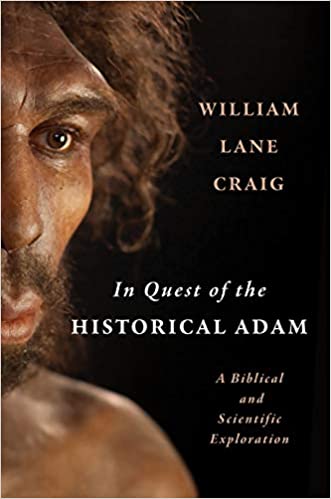Without doubt, In Quest of the Historical Adam is one of the most intriguing, challenging, and brilliant books I’ve read in a very long time, and for anyone who actually cares about human origins including whether Adam was an historical person or not, William Lane Craig’s new book is a must read for sure. Fair warning up front— it is not an easy read because of the depth and breadth that Bill Craig covers in this 380 some page book. I had to laugh when on p. 320 in a footnote he says this is a popular level book! Not really. It’s an academic book of the highest order. For theology students I will say if you don’t know your science and evolution pretty well, you’re going to have to get up to speed to take in some of the crucial chapters in this book. It is a tour de force, which is not to say that I agree with all of Bill’s arguments.
For example, I do not agree that Adam lived hundreds of thousands of years ago. I see no need to identify him as a particular specimen of, or contemporary of Heidelberg man. Indeed, I would say that Adam is a much more recent creature than that. Further, I don’t think it is necessary to argue that Adam is the literal ancestor of all current human beings. Neither the Genesis 2-3 account nor proper theology requires that. In fact I would argue that the Gen. 2-3 story is about the origins of God’s chosen people, the Hebrews. Indeed, after Gen. 1 which has a more universal perspective, the Bible is about God’s chosen people, and other peoples like say the Philistines only come into the account when they interact with the patriarchs, theHebrews, or later the Israelites, or finally with Jesus and his Gospel. But more about that in subsequent blog posts where I have a dialogue with Bill. Here I will say, the author has made an excellent case, and he could be right on various key factors and issues. He is certainly right that the earth is very old indeed, as are creatures on it, including a variety of humanoid ones. The question is, when and where do creatures created in God’s image come into the picture.
This book is divided up into four major parts: 1) The Importance of the Historical Adam; 2) Biblical Data concerning the Historical Adam; 3) Scientific Evidence and the Historical Adam, and 4) Reflections on the Historical Adam. The book is well organized, relentlessly logical in the way Bill argues, and thoroughly researched. There can be no complaints on any of those fronts. And frankly one is amazed at Bill’s degree of knowledge in so many diverse fields. Interestingly, while Bill deals with and agrees with evolutionary science in detail, in the end he still has to posit a divine moment, or divine intervention when a certain Heidelberg man had a soul/spirit infused into him which was not simply the next step in an evolutionary process. I have heard this argument before from Catholic scholars. Of course the problem with this argument is that the Genesis story speaks of being ‘created’ in God’s image, not upgraded after millenia of existence. But Bill will argue the Genesis account in case cannot be taken absolutely literally, though it is historically referential. He sees it fitting into the category of mytho-history. I wondered why he didn’t consider the categories of legend or saga. In any case he is right that there are metaphorical, and figurative dimensions to these accounts in Gen. 2-3. I also wondered why he didn’t deal with the considerable body of OT scholarship which suggested that the ancient Hebrews were demythologizers, not myth makers. They took elements from ANE lore and demythologized them (e.g. in regard to the creature Leviathan— see the various works of G. Ernest Wright and others).
The real strength of this book is both its comprehensiveness, as it raises and tries to address all the major questions, and the level at which these treatments are done. I know of no other book that does such a job with the science, the history, the theology, the logic, the anthropology etc. of these issues. I do find it odd that ancient religion doesn’t really come into the picture. What I mean by this is for example, the evidence of high places, sacrifices, worship. I would argue that if it is true humans are created in God’s image, and meant for special relationship with God, one should be looking for evidence of religious humanity, for example at the Gobeckli Tepe temple site in eastern Turkey, which goes back perhaps to 10,000 B.C. But more on this later. Bill has made his case in detail, and it deserves to be heard. Among other things, it rules out young earth anti-evolutionary thinking as a viable Christian approach to the data.













